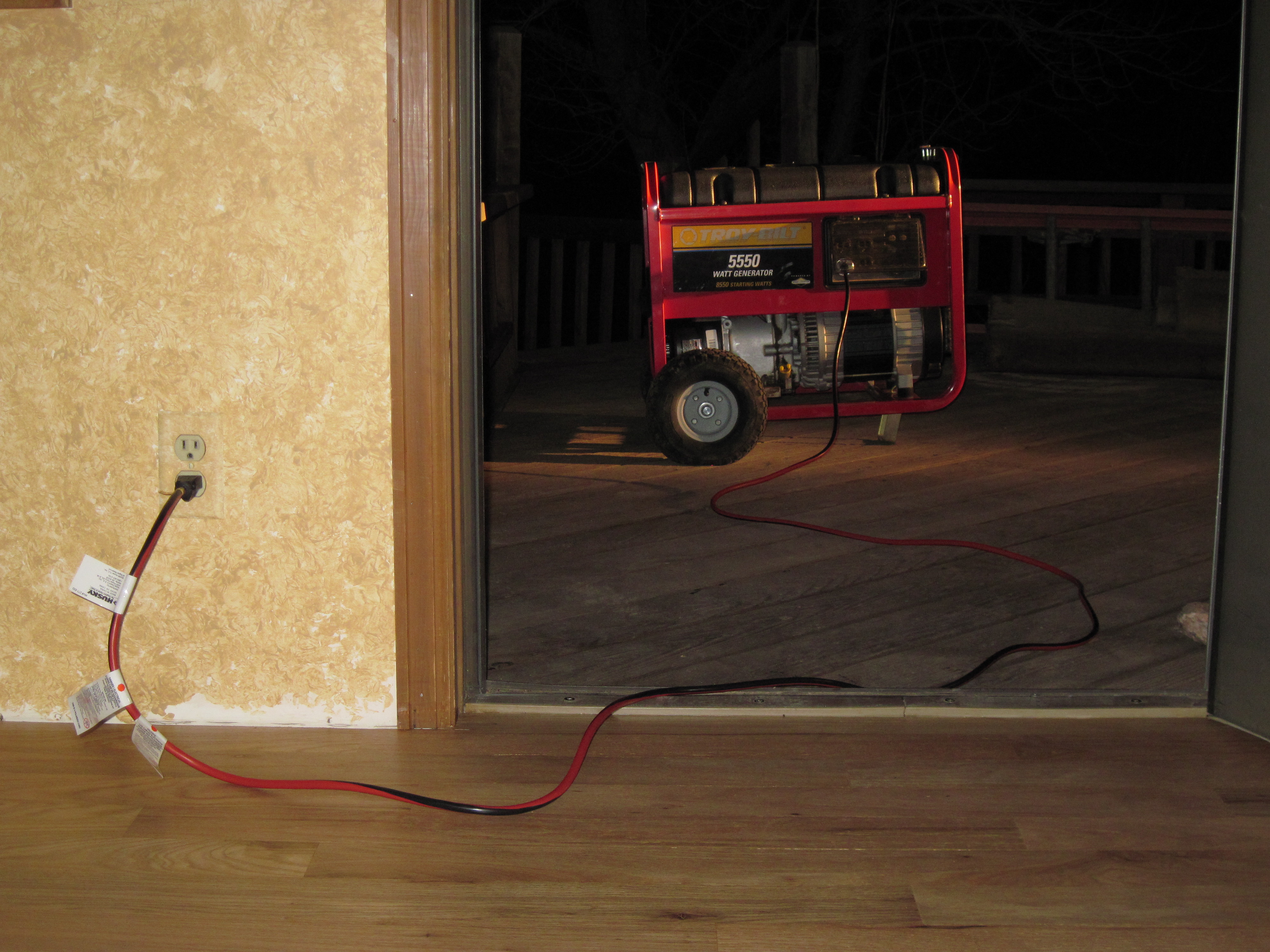
Update: This How-To was written for April Fools’ Day. It is not advised you attempt to make or even use this cable. The comments have made it very clear how dangerous to you and others using this cable can be. The image above is not of a full male-to-male cable, only the ground is connected, and the generator is not running.
We all know Ethernet has the crossover cable, cars have jumper cables, and RS232 has the null modem. Well, it is about time our wall sockets get their own crossover cable. This crossover cable is great for running power to a circuit disconnected from power. Maybe you are out of fuses, the breaker is broken or you just don’t want to go check the fuse box when there is a murderer about. This cable makes a great gift for even the most loathsome of acquaintances.
This an April Fools’ Day post. You should not do this!!!
Warning: These are Mains voltages and currents we are working with. If you do not know why you should not attempt this, you should not attempt this.
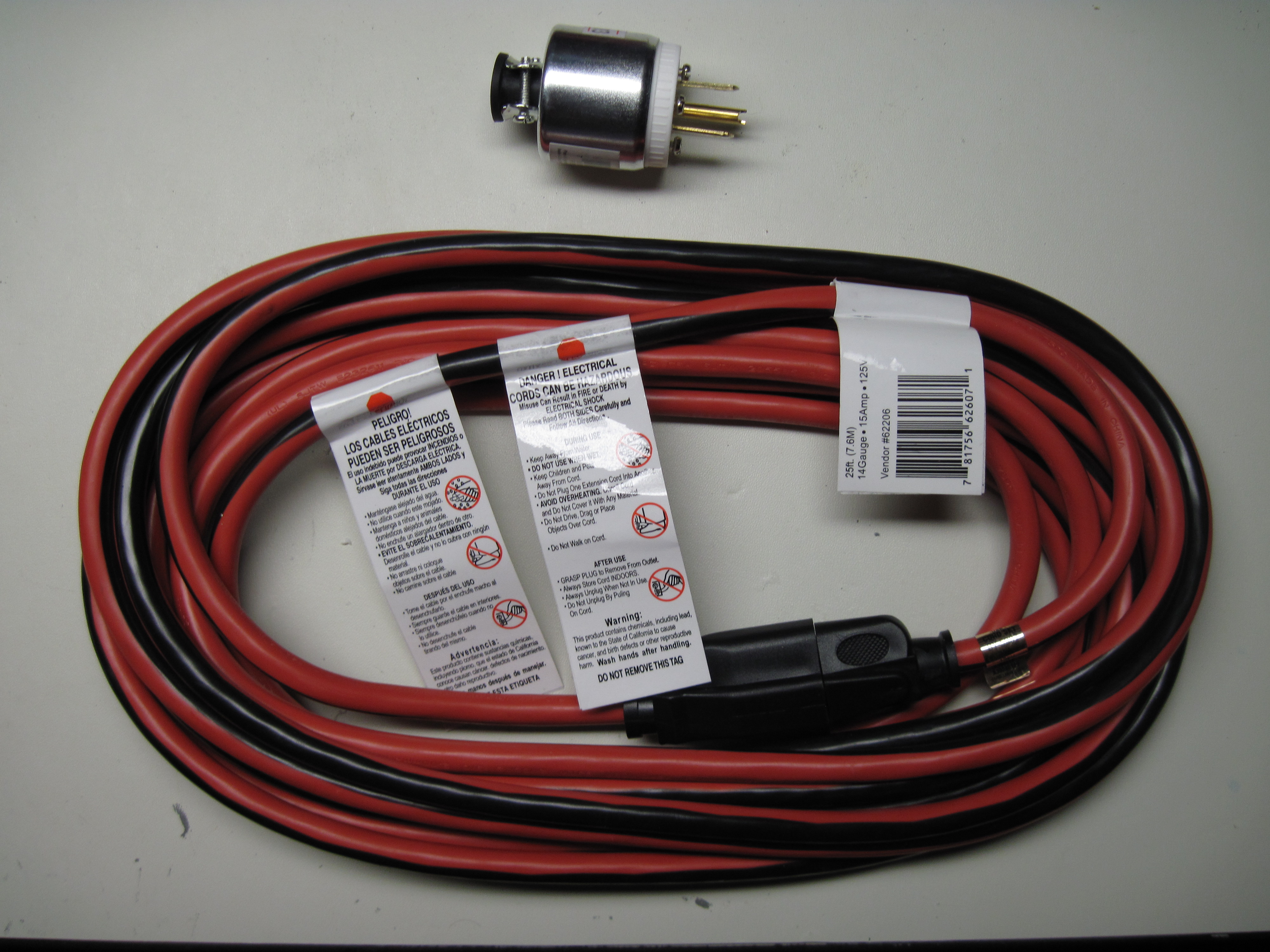
You will need:
- 1 Extension cord.
- 1 Male extension cord repair connector.
- Tools to strip the extension cord, and attach the connector: Knife, wire strippers, and screwdriver.
- Respect for mains voltages and currents.
If your extension cord has warning labels, read them.

Cut the extension cord to the desired length.
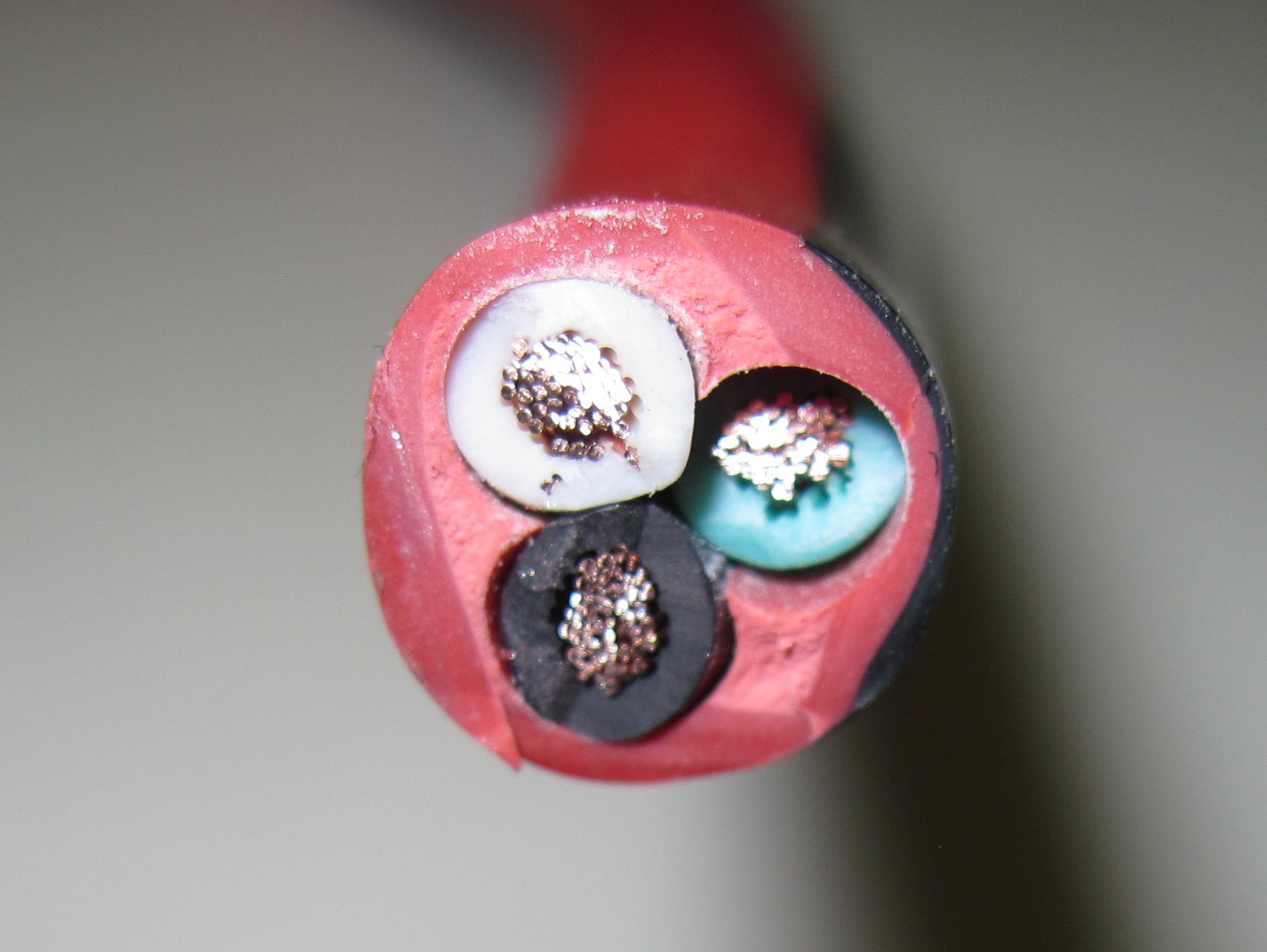
Strip about one inch (2.5cm) of the outer insulation from the part of the cord that has the male plug.

Strip about 3/8 inch (1cm) of each of the conductors. If there is a strip gauge, use it for a guide instead. Twist each of the stranded conductors to prevent fraying and possible shorts later.
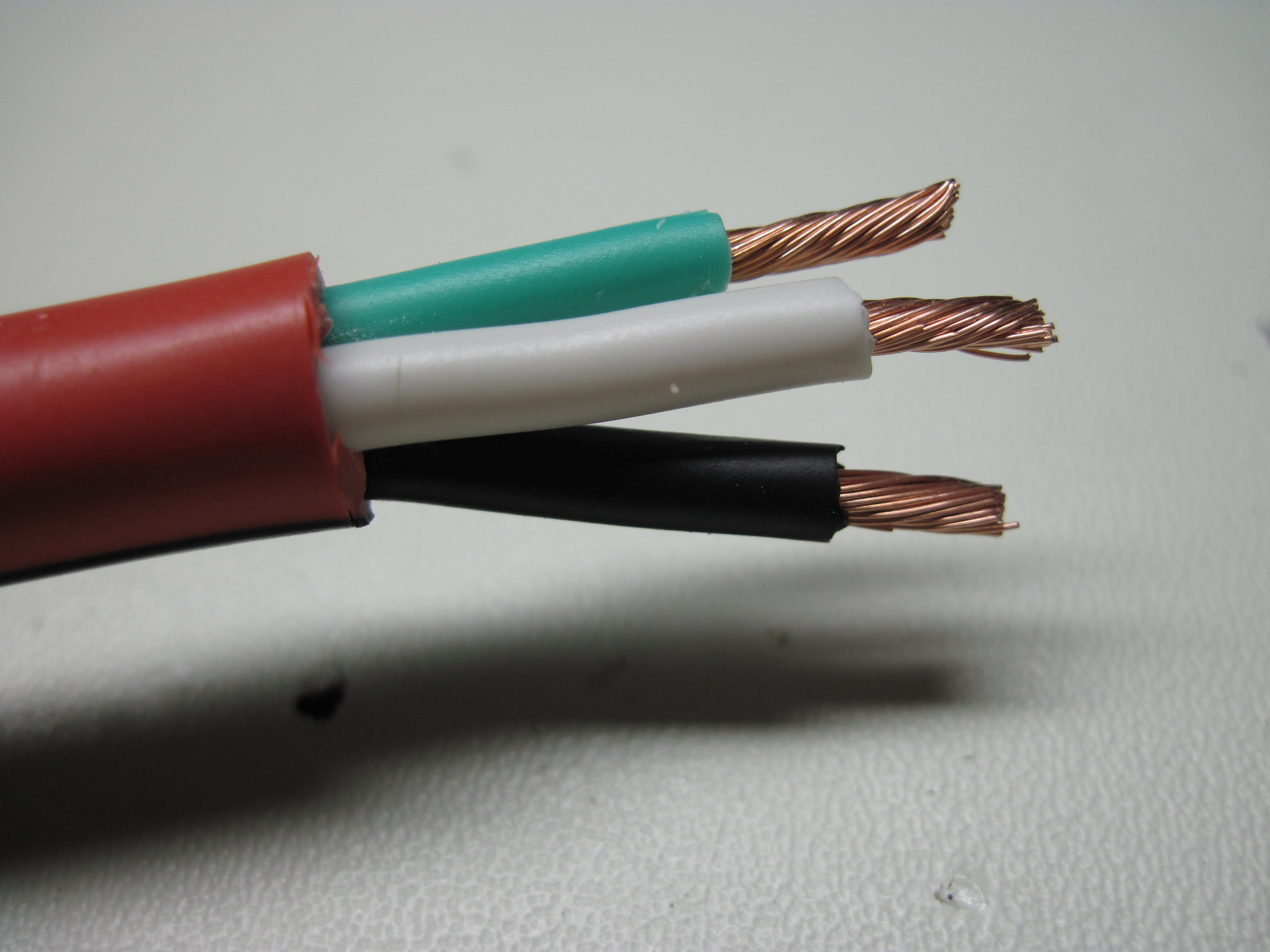
Slide the shroud over the cord.
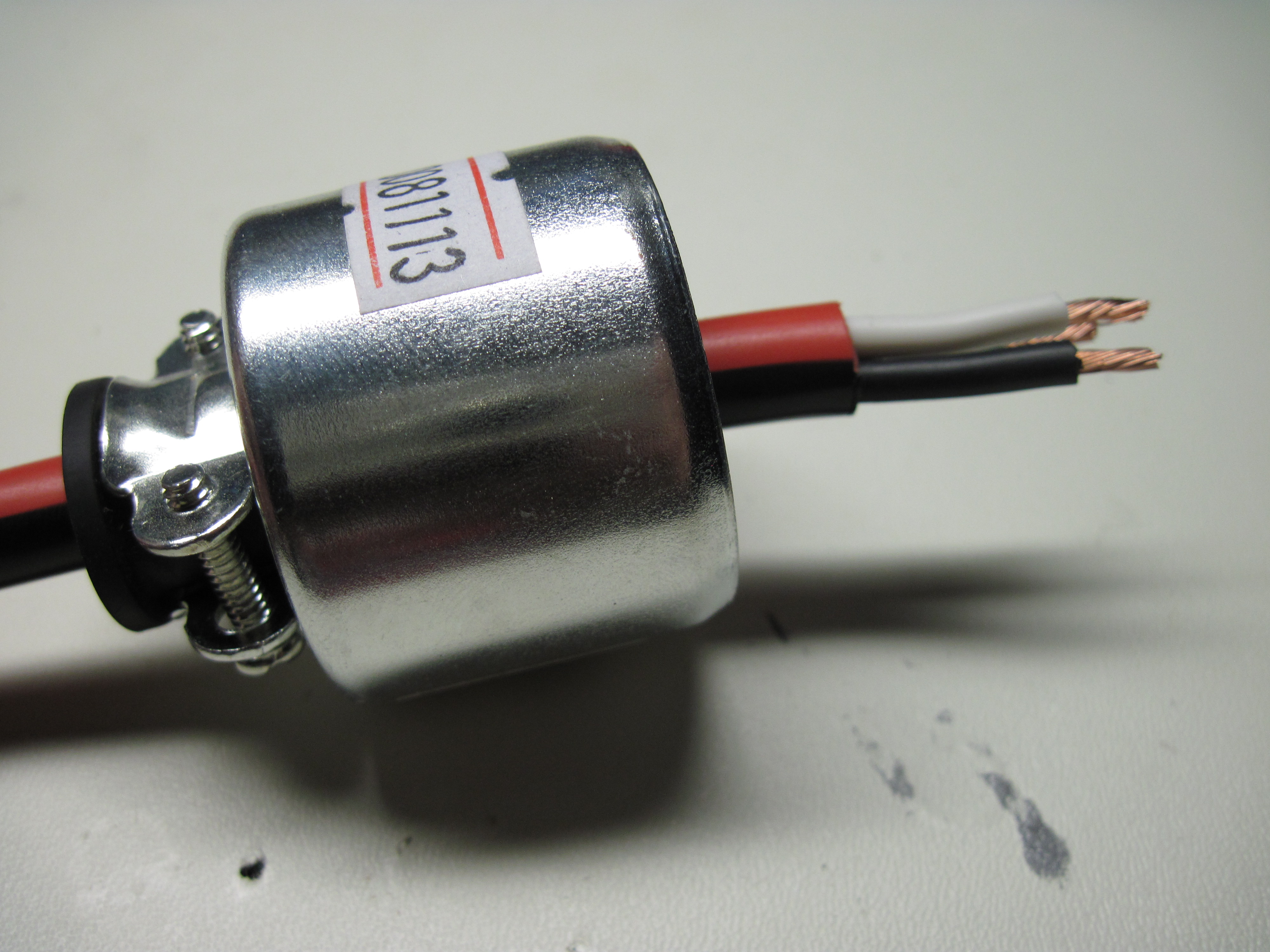
Screw the conductors into each of their respective terminals on the connector.
- The Green or bare conductor goes to the ground conductor terminal. It often has a green screw.
- The White conductor goes to the grounded conductor terminal. It often has a silver-colored screw.
- The Black conductor goes to the ungrounded conductor terminal. It often has a gold-colored screw.
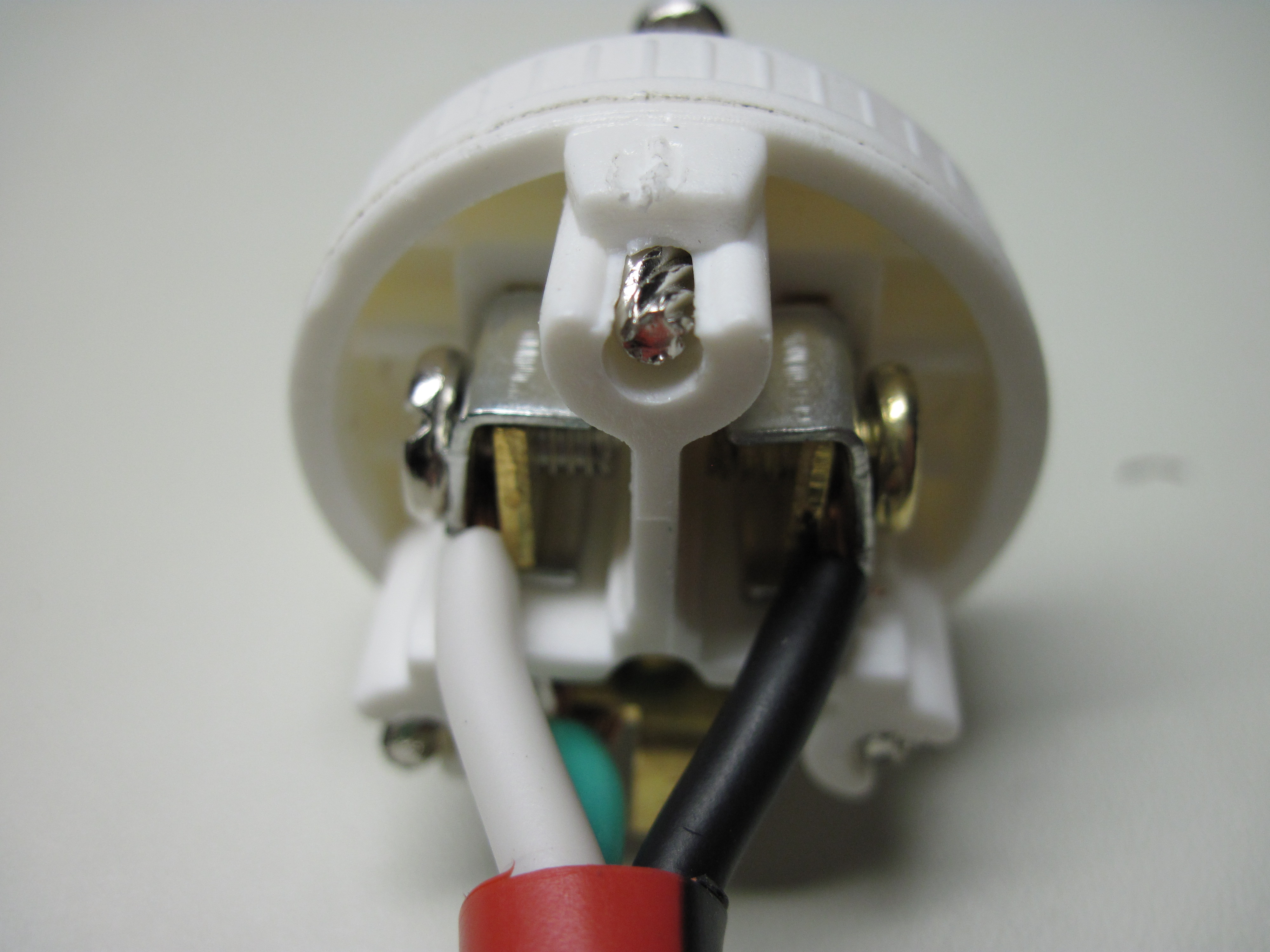
Use a multimeter to check continuity and make sure there are no shorts.
Slide the shroud up to the connector and fasten the two parts together.
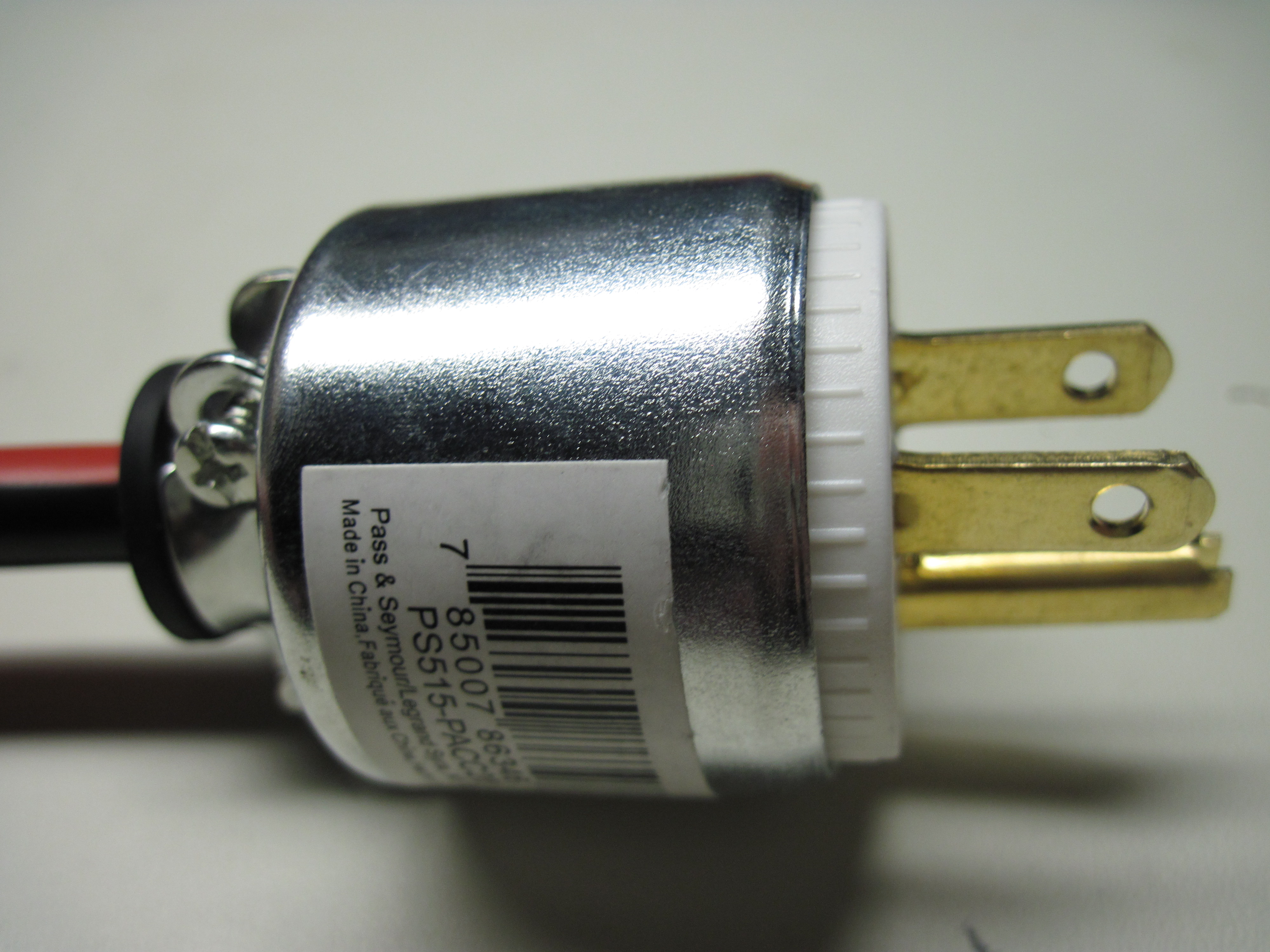
Secure the cable clamp.

There you have it, a finished Mains crossover cable.
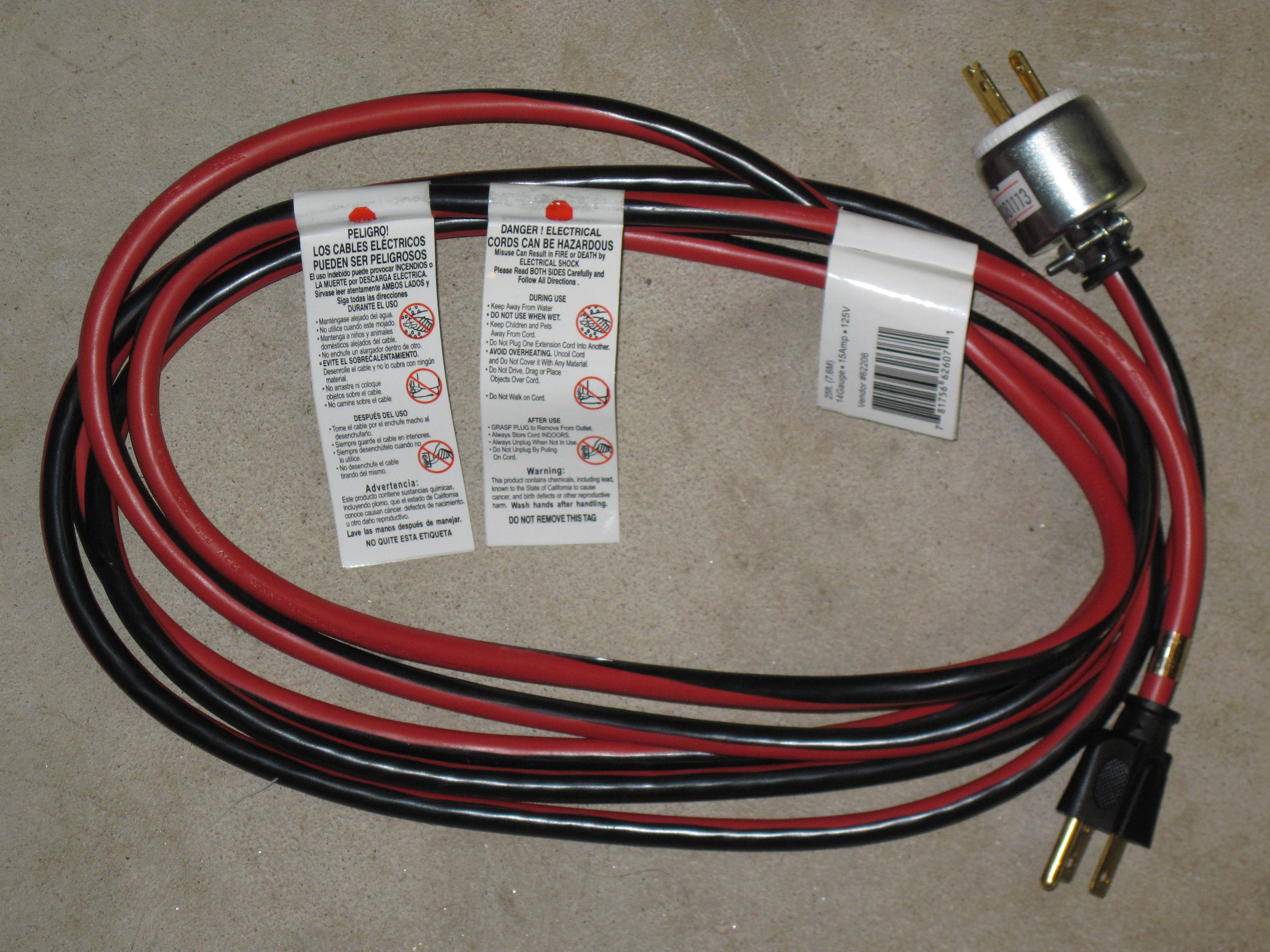
There you have it, a Mains crossover cable. How might you use this crossover cable?
















My GOD, someone is going to end up either killing their friendly lineman with this, or burning their house down.
Consider this:
Your fuse blows, because of a short in the circuit. You decide to power the blown circuit, via this cable, with an outlet from another room. You connect the live circuit to the shorted(and blown) circuit. The resistance of the power cable is high enough to prevent the live circuit from popping its fuse. The cable becomes a huge heating element. It burns your house down.
DELETE THIS. THIS IS NOT A “HACK”. THIS IS A HORRIBLE IDEA. THERE ARE MUCH BETTER AND SAFER WAYS TO GO ABOUT DOING SOMETHING LIKE THIS. YOU SHOULD NEVER, EVER, EVER CONNECT TWO CIRCUITS TOGETHER WITH A CABLE LIKE THIS, AND SHOULD NEVER, EVER, EVER DRIVE YOUR HOUSE VIA GENERATOR WITH CONDUCTORS THIS SMALL.
FAIL FAIL FAIL FAIL FAIL DELETE DELETE DELETE DELETE
hell i have been using one of these for years you just back feed in to the house PUT YOUR BIG GIRL PANTYS ON AND DEAL WITH IT LOL
This is a good idea actually. Screw linemen, did I ask them to steal my power to commit suicide? NO! So why would it be my fault if one died? Idiots, they work with much higher power every day. This is a great hack fully deserving of this site.
Bunch of right wing wankers want to ruin this site.
Hopefully someone else said this in the wall of text above.
This is a Mains CROSSOVER Cable. It will short your generator to ground.
And there the story ends.
1. First thing that comes to mind is how unsafe having exposed prongs that can potentially be electrified. Terrible idea, since if you grab the unplugged end of an accidentally energized cord, you won’t be able to let go. You’d probably be killed.
2. Someone who would see this article and decide it was smart to follow the instructions would not understand why they need to flip open the main breaker before a generator is connected, to separate their house from the power lines. If the generator is running and your main breaker isn’t shut off, and there’s a lineman working on a power line near you trying to repair something (very likely, since blown line transformers or downed lines are often the problem behind outages), they assume the line is not live once they have disconnected power company service to it. They would probably be killed.
3. Running an entire house through one 16-gauge extension cord? If you overloaded it, or the wiring behind that outlet (I believe a 16-gauge copper cord can only carry 1800 watts), it won’t trip the house circuit breaker, since most rooms on an individual 15 amp breaker have more than one outlet. It might trip the breaker on the generator, but only if the generator has less than an 1800 watt output. If you ran more than one high-wattage appliance at once (air-con, microwave, toaster, oven, refrigerator, pick any two), you would overheat the extension cord, which would eventually lead to a short, tripping a breaker, but would likely lead to a fire long before that. You could burn your house down.
There are probably many other comments like mine, but I don’t want to read the whole thread, and I feel this needs to be said (just in case it hasn’t been already)
@rit
And yes, I am aware this is an April Fools joke.
Ha ha ha.
Hundreds of people have been killed with setups similar to this.
Funny, right?
@rit
16 AWG is rated for about 10 amps. For a 120 volt circuit, that’s about 1200 watts. You’ll never find anything in your wall that’s smaller than 14 AWG, and some counties are now requiring 12 AWG even if the circuit is only 15 amps.
As it’s been said before, a generator should have individual breakers for its outlets. I have a 5600 watt generator. It has two 20 amp duplex Edisons, each with a breaker, and an L14-30, with its own breaker.
What I find funny is that I actually *DO* use one of these! (Not joking.) It’s an interlocking 240V cable made for this exact purpose. When the mains power fails, I can simply switch off my main connection (main breaker), and connect my generator using this type of cable. Though I agree with most of the comments here – do *NOT* try this unless you REALLY know what you are doing, and have experience and background in electrical engineering or electrical installation.
Now to follow up with the rest of the little wimps on HAD…
“OMG this can kill u! :( :( :( This hack should be deleted becuz i’m a reetard wif my Arduino…”
Jeez people, does anyone know common sense nowadays? I guess not.
Modern generators are equipped with breakers on their outlets (and some are even GFCI equipped) and unless you’re using the 240 volt line (which you’d better be careful with) none of your split phase devices would work (or anything that’s on the other phase than the one you’re powering…)
Idiots that would try this and NOT disconnect the main breaker shouldn’t even BE on a site like HAD and should rather watch something more appropriate, like the Disney channel.
Crack Heads do this all the time when there power gets cut off. They use their mains cable to tap into the backyard or the apartment next door.
Actually this reminds me of when I was 5 or 6 and took the spare electrical cord out of the junk drawer in the kitchen and got both bare ends of the wire under the thumbscrew terminal of a bicycle headlamp, that was a blackened outlet for several years.
After my dad quit doing an impersonation of how stupid I would look pedaling a bicycle while tethered to the living room outlet* I asked him where the headlamp got the rest of the circuit if you couldn’t hook both to the same terminal and that was when I learned about chassis grounds.
*(he must have been pretty young at the time as I was his first kid)
Then when I was 10 or so I had my first pair of needle-nose pliers, bent end. I was messing around on my brothers bunk bed and cut clean through a lamp cord with them, blew a nice chunk out of the cutters, blew the circuit and showered drops of burning metal all over the place, I don’t think they ever cut well after that.
You have to learn somewhere is basically my point.
they see me trollin’, they hatin’…
+1 hackaday
ps: YOU COULD DIE!
Once, when I was little, I was plugging in a night-light and my finger brushed against one of the prongs mid-insertion. The feeling through my arm was amazing–a sort of tingly, warm feeling. I’ve been dying to experience it again ever since. Thank you Hack-A-Day.
@ nubie
Can I borrow those pliers? I have a friend I’d love to show it to. He has a tendency of recklessly cutting up wires without thinking. Your pliers might get him to think with his brain for a second( he loves his tools to death)
@ the so-called “experts”
I’ll play the dummy and you can explain to me why in the hell will a transformer up-vert a current from a house when most pole transformers, by law, are required to be grounded to the pole and the netural connected to feed back into the grid( which is how they can help to stablize any frequency drift that occurs).
Wow about 265 comments on this!
Where can I buy a UL tested version of this?
As if all the iphone and arduino “hacks” weren’t lame enough…
the only times i DO find a decent article on here, you usually just ripped it from instructables,
why don’t you teach the kids how to build a bomb from household items while you’re at it.
so much for ethics or creativity.
A lot of people actually did this after the ice storm in Massachusetts that left us without power for weeks. It’s not the worst idea in the world as long as you make sure your line in is switched off! Luckily my house has a generator input so I didn’t have to resort to such hacks.
Hi Hackaday Editors,
I built this device today because my power goes out alot and it seems to work fine except for the cable gets pretty hot and makes a loud humming noise. I tried to run the generator faster but the dead lineman outside just started to smoke. Long story short, I’d like to know if there’s any more advanced versions that integrate a fan or perhaps an arduino that can be used to control a fan either for cooling the cable or dissipating the smell of the dead utility workers outside my window.
I already tried closing the windows but the generator exhaust made my baby pass out, which may also have been from the warmth of the cable that I had coiled in his crib. But the plastic coating melted a little and burned him, so I think he was really knocked out.
Overall, I have to rate it a 9/10 due to the lack of arduino and the small fire it caused – but you can still buy one from me on ebay: username is safechinaseller.
@SpenceJ
Sorry, I was thinking about those stupid non-grounded, three outlet extension cords for some reason. I have one 14 gauge extension cord (the long one) and two 12 gauge cords of moderate length for heavy loads. Ever since my friend burned down his camper with a 16 gauge lamp extension cord powering a space heater, I’ve paid a lot more attention to the load at hand, and made sure the cord I was using was up to the task.
calm down girls
Aw, and they rejected my idea for power-over-ethernet which uses a standard piece of ethernet cabling with RJ45 connector on one end an a regular mains plug on the other.
Also: Internet nerds taking everything literally… fail! ;-)
NEEDS MOAR ARDUINO
Posting a potentially lethal project on a site with a bunch of diy and passing it off as real…as a joke
completely irresponsible
Just lost some respect for hackaday
Only problem here is that it was posted as a joke. THIS IS NOT A JOKE. It is a hack that can be pulled off safely. Poster should have brought attention to the dangers, but that is all. ALl you tards complaining need to handover your not a douche fag cards.
Piku –
You’ve been reading old BOFH articles again, haven’t you. The etherkiller was invented years ago.
Should I dare say this? I’ll say it… What this project needs is a PIC uC!!!! Muhahaha.
@metis
The reason electrical engineers have no sense of humour around mains is because the electrical engineers that had a sense of humeur got fried long ago.
With the current influx of people thinking Arduino = hacking I wouldn’t dare to post that has sharp corner, let alone working with mains.
Just if you do try this…turn off your mains first….and make sure your wiring will support the current from your generator unless you want to burn down your house! Most household outlets probably only handle 10-20 amps… a 5000 watt generator is 40+ amps!
“Warning 10,000 Ohms”
comes to mind
Consider this:
Your fuse blows, because of a short in the circuit. You decide to power the blown circuit, via this cable, with an outlet from another room. You connect the live circuit to the shorted(and blown) circuit. The resistance of the power cable is high enough to prevent the live circuit from popping its fuse. The cable becomes a huge heating element. It burns your house down.
Well, dude, I had not considered that. You know, because I, like 99% of the world, would fix the short rather than go through your complicated scenario. Anyone know knows enough to backfeed gene power through a circuit also knows enough to not do it.
Can I borrow those pliers? I have a friend I’d love to show it to. He has a tendency of recklessly cutting up wires without thinking. Your pliers might get him to think with his brain for a second( he loves his tools to death)
C’mon, this is a DIY site. Why get his pliers when you can make your own?
So now that you’ve showed us how to burn the house down and die of electrocution by means of an illegal device, I was wondering if you could do a how-to on bombs made from household items.
Fucking idiots.
So now that you’ve showed us how to burn the house down and die of electrocution by means of an illegal device, I was wondering if you could do a how-to on bombs made from household items.
1. It isn’t illegal where I am.
2. Why bother with an explosive when you can make chlorine gas out of stuff from the laundry room?
JEEZ you people are sanctimonious crybabies. We seek not your counsel, nor your warnings. Crouch down and lick the hand that feeds you; May your chains set lightly upon you, and may posterity forget that ye were our brethren.
I have a homemade cable like this for this exact purpose. Of course in our breaker room the one outlet we can plug it into has a switch to cut off mains and have the ‘input’ be that one connection. it was just cheaper than getting the special plug that is identifyable as being for that purose.
Of course I was quite perplexed when I was younger before my father explained the custom layout to me =P
how many people…JUST realised, that this was posted april 1st?
oh btw, i do have a plug on my generator that grounds it when plugged into a outlet
just let it go people it’s over
@Frogz I just did, but i’m not one of 260 “omg its dangerous” commentators.
Here is a link to a generator transfer switch on amazon marketplace, for anyone who wants to offload being careful into hardware :)
http://tinyurl.com/notawidowmaker
Well, I would have thought the lack of LEDs would have given it away to most, but then again American Idol is a popular show, if you catch my drift.
Psh, this is a polished, clean hack.
For the manly version, forget the “male extension cord repair connector” altogether, strip the wires, and push ’em into the wall socket like your God-given testosterone told ya’ to.
Then flip on the tube and grab a cold beer from the fridge. Like a man.
@derp- I seriously almost fell out of my chair laughing. Thanks.
Funny all the hysteria reminds me when I was a kid I cut the plug off something and soldered an LED to the wires and plugged it in. I think I managed to shock myself at some point in the process too. Or maybe it was taking apart the camera flash that got me, I don’t remember.
Since then I’ve been shocked countless times with line AC and HV DC. It hurts, and you go “Damn, that was dumb” and you think twice next time. It’s how you learn to be safe if there’s not a giant DANGER label. It’s what they used to call learning, not lawsuit.
Now I carry a non-contact voltage detector and use it before I work on anything or touch a circuit. Any lineman that “assumes” a line is dead gets what he deserves, just like anyone who forgoes safety in a dangerous activity.
For what it’s worth, my horse trailer’s living quarters is powered almost exactly like this. The cord is different and so is the plug, but it feeds generator power into a breaker box. I run a water pump, water heater, lights, etc. Just make sure your circuit protection matches your wire size. Obviously, if you can’t figure that out, leave it to somebody that can. That’s kind of the point.
In case anyone was lost, this is “hack”aday, not “professional engineering”aday. If you could buy this from a company it would cost $249.
Oh, and to all the “don’t teach people how to kill themselves” folks: I once had to help my neighbor wire a light bulb and switch in his shed because he was just trying different combinations of wires and he kept blowing the breaker. He probably doesn’t have a computer and it’s pretty much guranteed he’s never been to this site. Point is: people don’t need any help with hurting themselves.
who’s a crispy critter today? anyone die yet?
I have a few things to say about this post….
1. – NOT Illegal. If you do this and your house burns up, you may not get insurance. That is about it.
2. Lighten up. Where I live, it drops down to minus 40 degrees in the winter. When ever we have a blizzard and a power outage, this is the quickest way we heat houses when the power is out for an extended time. (we being the local fire department). If this is done with extreme care and prejudice, this is a very safe and quick method of home power.
3. I have read all the posts here and i have come to the conclusion that the people who think this is a terrible Idea, don’t have a clue what they are talking about. I do agree with some people that the article could have been re-written with a way more precautionary outline and have warnings all over the place.
But in the end, our small comuninty relies on “hacks” like this to survive 5-7(7 being the longest without power) days with out any power or water during any kind a blizzard. Not sure if to many people know how fast a house gets when the wind is blowing at 50 miles an hour, and the ambient temperature outside is -40 to -45. With a wind chill that is around -60 to -70. Food for thought.
What the fuck? Why is everyone so freaked out? I have NEVER seen so many comments on one single hackaday page.
You people are seriously fucked for getting in a big frenzy about this. This is NO worse than many modifications that have been posted on here previously that could potentially damage/destroy everything from your computer/psp/gameconsole/expensive equipment etc.
You might damage your generator sure, but I’m pretty sure most people stick around when a generator is running anways. Cool the FUCK down guys jesus.
If used properly this “hack” can be used safely and without catasrophe, just like many other hacks on here. The same applies. It’s not anybody’s responsibility but YOURSELF if you kill yourself.
It makes me think of when I was a kid, and I did something and got in trouble at school because I did something that some other kid did. The teacher would always tell me, well if told you to jump off a bridge, would you?
It’s your fault like I said, theres people on here talking about how “hackaday” better hope they have good lawyers/liability. What the hell?
While I realize that this is an April fools post, and dangerous, and could kill you if used improperly, I have had to build one of these for a real-life situation: Plugging an RV’s electrical system into an extension cord in order to power the RV from my home’s A/C. The one I built was only 1 foot long, and employed a fuse, though.
i actually have this exact setup at home, not even kidding.
i have no clue why everyone is freaking out.
no, im not going to wade through a hundred posts.
i actually have this set up for when the power goes out in the house, i have it set up to go to the fridge circuit to keep the fridge running when the power goes out, i have the other plug going to my computer room circuit so i can keep playing my games.
this is actually a legitimate way to run your power.
lern2wire.
Not funny.
300th comment